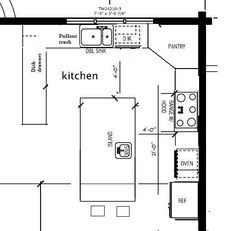As the nutritional hub of your home, the kitchen highlights and defines your nutritional and existential lifestyle in terms of functional work space, household hygiene, and dining ambiance. In order to fulfill all your functional and aesthetic needs, the kitchen should satisfactorily accommodate the cooking needs for the entire household, offer ample storage space, and feature a spacious, cozy and tantalizing dining space. When planning for a kitchen remodeling project, you should ensure that the desired layout style and decor matches, and even complements your home’s architectural motif and sets a dynamic tone for both formal and informal dining events. After considering the “ordinary” home remodeling factors like budgeting and project needs, goals and objectives (based on your personal lifestyle and preferences), you should shift your attention to the following issues.
Size
After highlighting the reasons/objectives for your kitchen remodeling project, you should now focus on the space usage/implementation. Ordinarily, kitchens are among the smallest rooms in a home. The first consideration during a kitchen renovation project is the amount and the planned usage of the available space. The size of the space will determine the final kitchen design and layout. In order to optimize space usage, you will need to analyze the existing and planned project design plans, styles, and features. Essentially, every inch of space, especially in a tiny kitchen, is vital. It is advisable to consult a professional designer or plumber to assist you in the intricate “economics” of space distribution. For instance, look for a competent and reliable DC plumbing company that offers kitchen remodeling/renovation services if you live in the Washington city area. Take time to discuss your remodeling project with these experts in order to get a realistic and practical solution to all your design predicaments.
Layout
Before you begin the kitchen remodeling project, you should consider and draft both the existing and planned space layouts. Although it is defined as a rough draft, a representative space layout should include accurate measurements and indicate specific features and installations for the entire space. Feel free to experiment with bold layout designs and styles that surpass the existing layout. Before you settle for a certain type of layout, consider the following factors: maneuverability/movement in the kitchen, functional capacity and viability, and the suitability for modifications or extensions. For instance, if you get “trapped” within the existing layout (maybe due to “immovable” walls and doors), implement innovative modifications like the curved or horseshoe layout to increase countertop space and free-space capacity, and to enhance functional efficiency.
Infrastructure And Appliances
In addition to considering the size of the existing kitchen space, you should also take into account the nature of the existing kitchen. In this case, “the nature of the existing kitchen” refers to the physical condition and age of the old kitchen. If the existing kitchen features very old plumbing and electrical systems (installations, fixtures and appliances), you must consider the inherent need, cost, and value for a full makeover of these systems. Old or infrequently maintained houses might have other contentious structural problems like sagging roofs, leaking floors and ceilings, and crooked walls, and you have to consider their refurbishment requirements. If you consult a professional for your home remodeling, you will be advised regarding the most cost-effective and convenient solutions and upgrades for all the infrastructural anomalies in your house.




